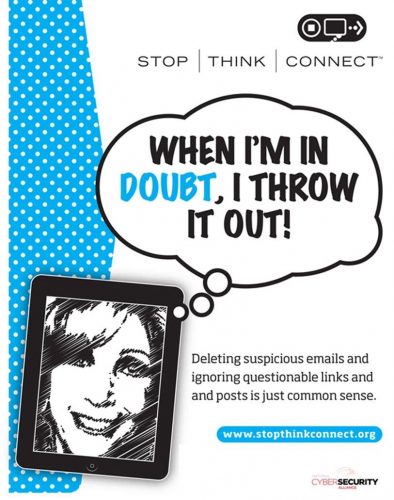WhatsApp is a popular communication tool, used by students and personnel every day. On the downside, it provides cyber criminals with another way to convince you to part with your well-earned money and unfortunately it’s usually quite convincing.
WhatsApp scams come in many different forms and are often very convincing. Just make sure that you stay vigilant and don’t fall for anything that seems too good or too worrying to be true. Just because a friend or a family member sends you something, it doesn’t mean that it is safe.
Voucher scams
A message arrives in your WhatsApp from someone who looks like your friend, recommending a deal they’ve found. The messages usually come with a link that actually takes you to another website and tricks you into giving your personal information. Don’t ever click a link you’re not sure of and certainly don’t ever hand over personal information to a website you haven’t checked.
WhatsApp shutting down
There are many fake messages claiming that WhatsApp is going to end unless enough people share a certain message. The messages often look convincing, claiming to come from the CEO or another official. They’re written using the right words and phrases and look like an official statement. Any official statement wouldn’t need users to send it to everyone like a round robin. You would either see it in the news or it’ll come up as a proper notification in the app from the actual WhatsApp team.
WhatsApp threatening to shut down your account
This is very similar to the previous scam. It looks like an official message that claims that people’s WhatsApp accounts are being shut down for being inactive. Sending the message on will prove that it’s actually being used and often instructs people to pass it along.
WhatsApp forcing you to pay
Similar to the previous scam, with the only difference being that the message supposedly exempts you from having to pay for your account – if you send it on to other people.
WhatsApp Gold or WhatsApp Premium
The claim suggests that people pay for or download a special version of WhatsApp, usually called Gold or Premium. It offers a range of exciting-sounding features, like the ability to send more pictures, use new emoji or add extra security features. The problem is that it is far from secure. Downloading the app infects people’s phones with malware that use the phone to send more fake messages at the cost of the original victim.
Emails from WhatsApp
Spam e-mails are bad enough. E-mails plus WhatsApp is even worse. There’s a range of scams out there that send people e-mails that look like they’ve come from WhatsApp, usually looking like a notification for a missed voice call or voicemail. But when you click through, you will end up getting tricked into giving over your information, passphrases etc. Don’t ever click on an e-mail from a questionable sender. WhatsApp doesn’t send you e-mails including information about missed calls or voicemails.
Fake WhatsApp spying apps
Currently, it is not possible to let people spy on other’s conversations on WhatsApp, because it has end-to-end encryption enabled, which ensures that messages can only be read by the phones that send and receive them. These scam apps encourage people to download something that isn’t actually real and force people to pay money for malware, or actually read your chats once they’ve got onto your phone.
Lastly –
Hopefully, you have already blocked sharing your WhatsApp details with Facebook (telephone number, name etc. and allowing Facebook to suggest phone contacts as friends) and Facebook will not be able to make your WhatsApp account accessible to the 13 million South African Facebook users.
There are some details about this controversial policy change by WhatsApp on the following page: http://www.mirror.co.uk/tech/you-can-stop-whatsapp-sharing-8893949
[ARTICLE BY DAVID WILES]



 Cybercriminals know the best strategies for gaining access to your institution’s sensitive data. In most cases, it doesn’t involve them rappelling from a ceiling’s skylight and deftly avoiding a laser detection system to hack into your servers; instead, they simply manipulate one staff member or student.
Cybercriminals know the best strategies for gaining access to your institution’s sensitive data. In most cases, it doesn’t involve them rappelling from a ceiling’s skylight and deftly avoiding a laser detection system to hack into your servers; instead, they simply manipulate one staff member or student.